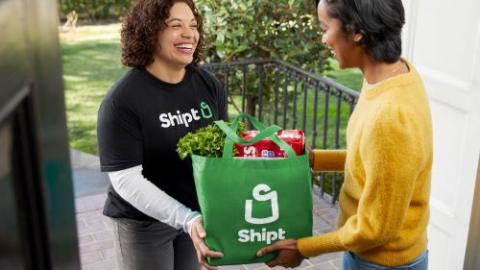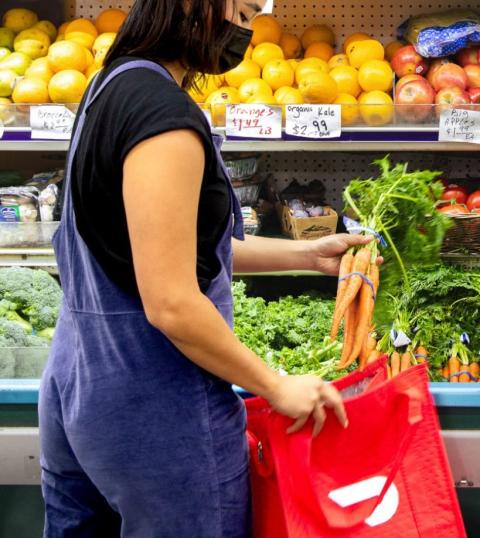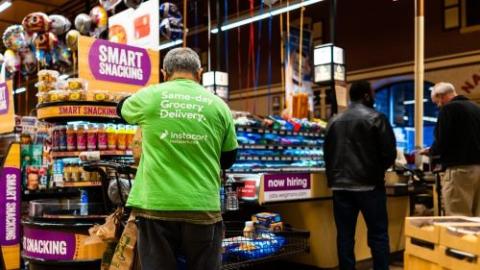Top Grocery Delivery Disruptors Divulge Their Secrets

Digitally based delivery has changed the grocery sector, with players in a constant frenzy to be the next biggest disruptor in the market, but the combination of demand, technology and experience, along with the recognition that a huge opportunity exists for whoever can drive the next phase of development, has service providers innovating intensely to put online ordering and at-home fulfillment on a par with in-store shopping.
Whether a company has evolved in the delivery sector or, like San Francisco-based Uber, has converted a compatible operation to take a unique approach to domestic drop-off, ongoing investment and technological advances promise rapid evolution.
[Read more: "The Next Evolution of E-Commerce"]
Shipt, of course, has been among the more recognized delivery companies, not only for its early appearance on the delivery scene, but also for its operational development and rapid growth. However, its acquisition by Minneapolis-based Target lifted Shipt’s profile even further, which has not only changed the course of its development, but also that of the big-box retailer, which has quickly made pickup and delivery much more central business functions.
In essence, disruption is in Shipt’s DNA, according to the company’s chief business officer, Rina Hurst.
“Shipt originated as a disruptor in the retail technology space,” says Hurst. “It goes all the way back to our roots: founded in 2014 in Birmingham, Ala., with a goal of helping individuals with little or no time for grocery shopping. As Shipt has grown, we’ve leveraged our technology to empower consumers and retailers alike. For retailers, Shipt offers an easy solution to bring both the convenience of reliable delivery to their current customers and an opportunity to meet new customers for incremental sales.”
She adds: “Third-party delivery services leverage scale across a market to keep costs for partners low and can flex their business models to prepare for peaks in retail demand. Companies like Shipt can offer grocers support that would be extremely capital- and labor-intensive for an individual grocer to buy or build and maintain.”
Shipt maintains a commitment to developing first-to-market delivery operations that prioritize the changing needs of an extremely diverse group of customers, notes Hurst.
Meanwhile, DoorDash is coming up to its 10th anniversary in business and continues to look at the flexibility built into its delivery capacity as an original basis for disruption, and the foundation of its ability to be a disruptor in the future, as well as the basis for future disruption in reaching customers.
“DoorDash’s goal since day one is to empower and grow local economies,” asserts Fuad Hannon, VP new verticals for the San Francisco-based company. “We’re focused on helping businesses compete in the digital economy.”
DoorDash’s beginnings in the restaurant sector, with high-volume, relatively low-value deliveries made with speed, precision and an understanding that affordability is a central issue, set a foundation for its emergence into the grocery sector, where the business is lower volume and higher value. As such, before venturing into grocery stores, where there may be 50,000 SKUs compared with a few hundred items on the most expansive restaurant menu, DoorDash had already faced and addressed critical challenges in the delivery sector and made its service work. And it did so, it’s worth noting, despite the fast expansion of pickup windows and takeout parking spaces added by restaurants even before the COVID-19 pandemic.

Indeed, confronting and systematically addressing such increasingly complex retail sectors as grocery are consuming the company’s time and investments these days, but DoorDash already has come to understand that the ability to be flexible is critical to the future of delivery in the grocery sector.
The company already services grocery store shoppers through its own app and through the proprietary apps of its customers. As such, it can support the agenda of its partners, which can include driving digital orders through their own apps and gaining the data that they provide. A retailer’s use of the DoorDash app can also bring new customers to that business, and a partner can choose to operate through both apps as well. DoorDash also works with different methods of fulfillment, given that its Dasher associates can shop orders themselves or accept completed orders when store personnel do the picking.
As DoorDash has gravitated beyond restaurant delivery to grocery and other retail, the company has established a standard to follow as it proceeds to the next iteration of delivery, one where consumers begin to more thoroughly integrate store and online grocery shopping into their everyday habits. As such, the company is looking at how the online and delivery experience can compare with the best retail environments.
“Then what has to happen is to make this as seamless and delightful as shopping in the store,” observes Hannon.
He emphasizes that grocery delivery is still in its earliest stages, but that DoorDash, with the flexibility of its platform, which can integrate other systems and function through retailer apps, is working on how to make digital food shopping just as comfortable, and, as soon as possible, as familiar an experience as shopping for food on a sales floor.

The Next Phase
Over the years in which the company developed its grocery delivery model, San Francisco-based Instacart has been able to develop technology and experience that have helped it gain traction based on a deepening understanding of the food retailing industry and its complexities, according to Chris Rogers, the company’s chief business officer.
“This knowledge has allowed us to build the technologies to power online grocery for retailers of all sizes, helping our partners effectively compete as customer preferences continue to evolve rapidly,” notes Rogers. “Together with our grocery partners, we aim [to create] the most seamless, affordable and personalized experiences possible to serve customers. Since our founding, we’ve focused on bringing grocery shopping online and have since expanded our role to be a foundational retail enablement partner, dedicated to helping retailers compete against digital-first competitors and win. We believe technology will continue to play a significant role in up-leveling and seamlessly integrating the online and in-store experiences for consumers, improving operational efficiency and inspiring greater retailer profitability.”
Instacart has helped lay the foundation for the next phase in the grocery sector’s development, contends Rogers, one where the store visit is only one of several options that consumers will pick, depending on their needs at the moment.
“We believe grocers can and should offer customers the latest in e-commerce, fulfillment, in-store innovation, advertising and personalization — everything they need to build the store of the future,” he says. “Through the Instacart Platform, we offer retailers solutions to provide a more personalized grocery shopping experience, both online and in-store. We also work closely with our CPG brand partners to develop new ad offerings that help them connect with and inspire their consumers, and measurement capabilities that help them more deeply understand the impact their ads are driving on Instacart. Our goal is to continue to create innovative technologies and solutions that help both CPG brands and retailers connect with their customers in a new way.”
Of course, technology has driven immense change in how people and things move across the landscape today, and not just in home delivery. However, the flexibility built into modern technological systems has allowed them to multipurpose in interesting ways.
Uber is a case in point. The rideshare provider has taken its basic business model and developed variations such as Uber Eats. As it did so, Uber took the experience and proficiency that it developed, and then repurposed them to create its dedicated food delivery system.
“At Uber, we bring a few unique things to the table for merchant partners: our technology, our global logistics expertise and our strong consumer brand that comes with a built-in user base of more than 100 million consumers around the world,” says Therese Lim, who leads Uber’s Product Team for Grocery. “We’re hearing interest from our grocery partners — both new and those we’re talking about working with in the future — in being omnichannel retailers: They want to meet customers wherever they are and however they’re looking to shop on any given day.”
The 100 million consumers worldwide who are already interacting with the Uber platform are a dynamic audience, Lim notes, “looking to go places and get things delivered; this means we’re an attractive place for retailers and grocery brands to reach new and existing customers. Our delivery network provides retailers with broad coverage to help expand their delivery service areas. Across the country and around the world, we’re uniquely positioned to help them get what they’re looking for from the merchants they love in under an hour, whether they’re cooking and forgot an ingredient, or planning their weekly shop and just don’t want to jump in the car. These are different kinds of shoppers, and we’re looking to satisfy both with an experience they can count on.”
The pandemic-forced rapid development of grocery delivery networks has been a major challenge all around. Consumers are themselves adapting to the new features and functions that the grocery marketplace offers. Companies providing delivery services have had to update their operations quickly and almost constantly as competitors and consumers alike weighed their options. Lessons learned had to be quickly applied.
“One of the things we learned when we started building for grocery retailers is that there is no one-size-fits-all approach, especially as we work in more than 30 countries around the world,” says Lim, “and each market brings its own unique expectations and challenges from retailers.”
As such, delivery businesses have survived and grown based on their ability to quickly adapt in response to consumer demand, retail need and competitive pressure. Uber is another operation that saw a need to accommodate retailers that want to have their own employees shop for delivery orders, as well as those that want a partner to take care of the picking.
“As a result, we’ve built for both options to give retailers more control,” notes Lim. “Our team designed new features like item replacements and live order tracking to create a more seamless experience for consumers, shoppers and grocers. Grocers have made it clear that they want a seamless experience with a reliable partner. We’ve made those expectations the cornerstone of how we build products so that it comes through in our platform experience and other interactions grocers have with Uber Eats. We’ve also invested heavily in what we call Uber Direct, which is our white-label delivery-as-a-service option for retailers to plug into their own e-commerce platforms. Uber takes care of the delivery and logistics, while the retailer manages marketing, order intake and the customer relationship.”
For DoorDash, the company’s associates who are in stores picking orders for consumers are critical assets that have to be carefully considered.
“There’s a lot done in terms of identifying who are the right Dashers for these kinds of dashes,” affirms Hannon.
Each associate is evaluated specifically for their ability to get orders right, and who might be diligent enough to handle an order of 50 items rather than five or six, as would be the case with a restaurant pickup. For restaurant orders, speed and efficiency are of the utmost importance, but for grocery orders, DoorDash looks for associates who understand that it’s important to take enough time to ensure that they reach the customer with the correct order. The need to do so is particularly important with perishables such as produce, where selection can be subjective. By interacting with customers, notes Hannon, the same Dashers who have the patience to select other products appropriately can get the best idea of just what the right piece of fruit or best example of a particular veggie is.
The flip side of getting the order right is working with grocers to have a better grasp of what’s in stock so that consumers are provided with the correct choices and issues such as substitutions, which can be pain points for consumers, don’t come up.
“One of the key things we have to nail down with grocers is the problem of understanding what’s in stock,” says Hannon.

Just Right
A key to how Shipt has helped to reconfigure grocery shopping is a recognition that the hunt for just the right foodstuffs is a personal priority that means more to consumers than just acquiring sustenance.
“Our teams spend a lot of time thinking about ways to make a delivery experience more meaningful at the household and individual levels,” says Hurst. “We take pride in listening to our customers and are conscious of their ever-evolving shopping needs. Personal shoppers are Shipt’s true differentiator. They shop the same way customers would shop for themselves and have proven the power of building relationships within the delivery experience. For example, our first-of-its-kind Preferred Shopper feature has been quickly adopted by both shoppers and customers across the country, showcasing the importance of personalization and relationships to today’s customers.”
The Preferred Shopper initiative allows consumers to pick their favorite Shipt picker.
According to Hurst, it’s one example of how Shipt has remained a shopper-centric company and continues to improve its relationships with consumers. In doing so, Shipt is moving toward a new phase of delivery that can draw more customers by better satisfying their preferences.
“Another really great personalization product we launched is Shipt’s dietary preference feature,” she adds. “Customers can go into their profile and save their dietary and wellness preferences, such as keto diet, Paleo, vegetarian, vegan, sugar-free, low-sodium and organic. When customers search for an item in Shipt’s catalog, Shipt will boost and tag the items that match the customer’s saved preferences. When a [Shipt] Shopper claims a customer’s order, a customer’s dietary preferences are available to them and served up during product substitution searches. While Shipt is a technology-based company, we believe that this desire for human connection will continue to have an edge over digital-only solutions.”
In in similar vein, deep relationships with partners are key to advancing Shipt’s delivery services.
“A strong and collaborative approach to partnership is absolutely critical,” emphasizes Hurst. “Shipt takes a personalized approach to each partnership, working hand-in-hand with our retail and CPG partners. Each retail or CPG partner we work with has a dedicated partner success manager who is backed by an entire cross-functional team within Shipt to ensure full support of our partner’s business. Our partner success team is committed to unparalleled service, figuring out what makes each potential partner unique, understanding the needs of their customers and making sure we are scaled to support their business. Unique to our industry, at Shipt we work collaboratively with our retail and CPG partners to understand data [and] performance, and identify insights to drive our joint business forward, whether it be focused on awareness, trips or baskets.”
Despite challenges ahead, the accomplishments and technological innovation that have driven delivery operators suggest that they will only become more proficient at what they do and more appealing to consumers while providing grocers with more ways to satisfy demanding customers.
For its part, Instacart aims to empower grocers to better serve their shoppers, asserts Rogers.
“We aim to be the backbone of the industry, building the technologies that support our retail partners’ business online and offline,” he says, “and in doing so, we believe we can help our partners effectively compete, and invent the future of grocery together.”






